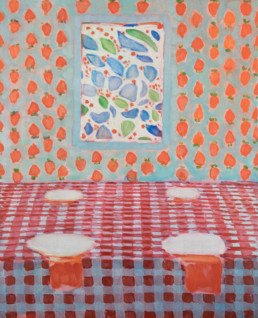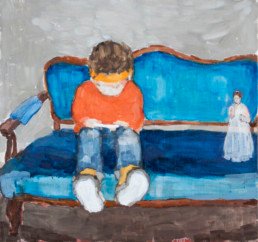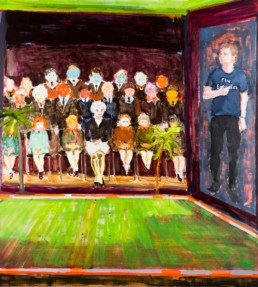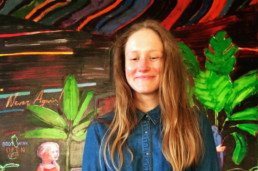AUKSE MILIUKAITELET'S DANCE A FORBIDDEN DANCEOIL ON CANVAS80 X 100 CM
AUKSE MILIUKAITEUNTITLED, 2015OIL ON CANVAS80 X 65 CM
AUKSE MILIUKAITEIT SNOWS PHANTASMAGORICALLY AND I'M ABOUT TO DIE (A CLOSER LOOK)OIL ON CANVAS50 X 40 CM
AUKSE MILIUKAITEBOTANICAL GARDEN NO.2, 2015OIL ON CANVAS40 X 50 CM
AUKSE MILIUKAITESHE IS WITHOUT A PARROT, 2016OIL ON CANVAS80 X 85 CM
AUKSE MILIUKAITENAKED, 2016OIL ON CANVAS55 X 38 CM
AUKSE MILIUKAITETWO MANTAS AND SUMMER BUTTERFLIES, 2016OIL ON CANVAS100 X 140 CM
AUKSE MILIUKAITEARSENAL WILL PLAY TODAY AT 4.15 PM, 2017OIL ON CANVAS110 X 100 CM
Born 1990, lives and works in Vilnius, Lithuania
Education
2015 – 2017
Vilnius Academy of Art, Master program of Painting studies, Vilnius, Lithuania
2011 – 2015
Vilnius Academy of Art, Bachelor program of Painting studies, Vilnius, Lithuania
2009 – 2010
London University of Arts, London, UK
2005 – 2009
Kaunas Antanas Martinaitis Art School, Kaunas, Lithuania
Solo Exhibitions
2016
July. Duality, The Rooster gallery, Vilnius, Lithuania
2013
8½. Dream, VDU gallery 101, Kaunas, Lithuania
2008
Personal exhibition of photography, Kaunas city museum, Kaunas, Lithuania
Group Exhibition
2017
International art fair ArtVilnius’17, The Rooster Gallery, Litexpo, Vilnius, Lithuania
International art fair YIA Brussels #9, The Rooster Gallery, Brussels, Belgium
2016
International art fair YIA Paris #7, The Rooster Gallery, Carreau du Teple, Paris, France
International art fair ArtVilnius’16, The Rooster Gallery, Litexpo, Vilnius, Lithuania
International art fair ART LUCCA, The Rooster Gallery, Lucca, Italy
Wunderkameraden, Meno forma gallery, Kaunas, Lithuania
2015
International art fair ArtVilnius’15, The Rooster Gallery, Litexpo, Vilnius, Lithuania
Thursday review, Vartai gallery, Vilnius, Lithuania
2014
One and more: local stories, Nida art colony, Nida, Lithuania
10 plain-airs of Silavotas, gallery Meno parkas Kaunas, Lithuania
Collections
2017
COBALT Legal, Lithuania
Lewben Art Foundation, Lithuania
2016
Modern Art Center Vilnius, Vilnius, Lithuania
Awards
2007
Main prize at international competition „Cultural Heritage in Photography“, Strasbourg, France
INTERVIEW
Aukse Miliukaite about her work and the online show at Collect Good Stuff
JG: You were grown up in Lithuania but your academic career started at the London University of Arts in 2009. For what kind of studies did you decide at this time and how did this influence your development as an artist?
AM: I have studied there photography for one year. Studies introduced me to theoretical classics (Barthes, Berger, Sontag, Benjamin), taught me to develop color photo rolls or to work with tutors outside uni with individual commissions. So all these layers of pictures, slides gave an idea of that connection between two mediums. The double life (painting and photography) was lasting for four years before London with two art schools, one was more into arts and painting, another – into photography in Kaunas (LT). And when I got to London, discovered all amazing opportunities, artists, streets, museums, music, city itself, I understood that I had missed painting very much. I even worked as an art handler to be closer to all the process of painting.
JG: Why did you choose finally painting as your medium?
AM: Well firstly, understanding of ability to connect the mediums, experiences, schools. Secondly, it is nice when I see in an artwork that personal touch or poetical filter that was made by hand. Lastly and most importantly – once I started, I can not get enough: the relations of color; multitudes of layers; contemplation time before, during and after the painting; possibilities of accidents, smells and textures – all the mentioned and not mentioned things make the painting primary and necessary medium.
JG: Your paintings open up a completely new world of images to the viewer by using fragments of different epochs, styles and contents. The spectator might discover references to old master as well as to modern and contemporary artists like Henri Matisse and Elizabeth Peyton. Can you describe your artistic approach and your interest in composing new art works with still existing images?
AM: We live in a world where there are loads of artworks that have already been made. Bourriaud in Postproduction mentioned about artists who remixe available forms and data, he compares artists with DJs. I would like to add that this sort of living where there are many links, associations makes us all DJs, creating a field or a store of images, for this instance, in our minds. Like Swann from „Remembrance of Things Past. Swann’s Way“ was seeing Odette as Sephora from fresco made by Botticceli called „The Trials of Moses“. His fantasy or desire to project what he wishes to see created phantasmal idea of Sephora. This particular example shows damaged conciousness encounter with reality or commonplace interaction with art history and its territories. Imagine, you wake up and forget all important things written by the images (when or where were they done), you try to link them using your own tags. Like value recalculation. So I select images, reproductions related to my personal stories and connect them with snapshots from daily life by making layers and collages. Another thing happens when it gets to screens instead of paper, when a painting (reproduction) appears on a luminous screen.
JG: What do authorship and originality of a work mean to you as a contemporary artist?
AM: I guess this is important question having in mind all the online possibilities we have now. Swetlana Heger raised the question whether there is a line between inspiration, appropriation and plagiarism. When the painting is taken from my place of creation, I consider that the image is not only mine. In film „All that jazz“ (1979) there is a scene where you doubt who is an author or director of the show. On the other hand, speaking about originality, it is great when you can tell straight from the look „oh, this is Llobera“, for example. So I do hope in a near future that originality sign would be crystal clear with my works as well.
JG: By using historical paintings and the today’s visual culture as well as fictional and non-fictional elements in your art works the viewer must leave the common path to read a painting by creating a personal relation to it. At the same time you are telling the recipient about yourself through objects and subjects. What role does communication play in your paintings?
AM: After finishing a painting, I like to show it to my close friends or family and ask them what they see, what they think, is there that communication. Sometimes they find what was intend to be found, sometimes create another stories related to their own. Painting starts its own life with myths and stories.
JG: Referring to the online show at Collect Good Stuff you are dealing with reproductions of your own paintings. What was the idea behind the exhibition „Red Room: projected reproduction“?
AM: In my creational project I create a space, where mirages, utopian situations are born – just like in the red photography room, where I develop other mirages. When I paint I analyze my teachers’ and culture influence that affects my art. By using postproduction I repeat, appropriate, destroy or recreate previously made artworks. By using collage and diary method I create situations, where cultural figures mix with my close friends, family. Personal stories or states of mind lead the union of artefacts. Artefacts themselves become the characters in my stories. By using latter methods, even without knowing the cultural figures, one can create one’s stories, using one’s personal associations. On the other hand, I search and discover my relationship with close or not so close friends, family; by using my memory, associations, imagination filter I remember my past experiences. My observed objects or family members become a part of me and my self-portrait.
JG: What kind of question do you raise by examining your own creative process?
AM: While doing this project, I asked myself, whether an artist could not be influenced by other artists and at the same time participate in active cultural life. By ignoring the answer to this question, I have decided to use those influences to create my work. Fictional characters are mixing with relatives or persons from around. Haunted characters moved from reproductions to appropriated pictures are not copied. Not authenticity, nor semblance of original work are important but the reason why works or their fragments created in the past are revived. I research how information that is in the memory is deformed and becomes works of postproduction. Using mirages I create oasis in which I communicate with appropriated and present heroes. So it is interesting what leads those exact characters to appear by the palm trees. By painting and putting situations to absurd, I try to define and reduce the line between art and daily life.









